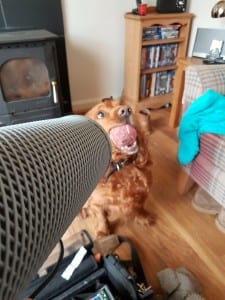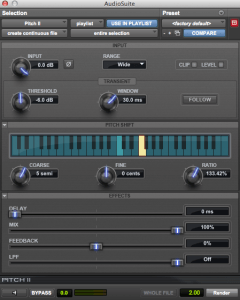Production
I received the final motion picture lock off the animation team, allowing me to start the production. I decided to split the work up into section, allowing me to manage my time well. I would first concentrate on the SFX required for the animation, then the Foley, then the ambience and then finish off with the music.
Within Pro Tools, there is a function where you can create blank clips, creating cues, allowing you to organise your session well, so you can identify what sounds go where. This function proved incredibly useful to me, as it allowed me to manage my time well, in order to achieve the deadline.
SFX
When it came to undergoing the sound effects process of my production, it required me to both source sound effects and record them. I used both the sound effects library in Sound Theatre A and online sources. I needed to make sure they had the audio requirements for me to me to import them into my session; requirements being a sample rate of 48Khz and a bit-depth of 24. To meet my learning out comes I made sure that every sourced SFX used was manipulated by me in some way, improving my skills in editing SFX. The main sourced sound effects were sounds that I couldn’t record myself, examples being rocket ships, gun shots, electronic beeps and bloops. In order to make these sourced SFX individual, I manipulated them so that they had more of an impact on the audience. For example, I layered two gunshot sample together, as one sample gave more of a bass impact and the other had a long tail of reverb; This in effect made a singular gunshot have impact and reverb, reflecting the atmosphere. I used EQ plug-ins on the rocket ship, increasing the low-mid frequencies, giving the sample more of a rumbling feel, so it felt like it was taking off. (see picture below)
Recording SFX was great fun. I focused primarily on creating an opening and closing effect for the Time Capsule in the feature. Relating back to my research on recording sound effects, Ric Viers stated that you need to record every day sounds that use could use and manipulate in some way, so I set that as a benchmark to achieve. For the opening of the time capsule, I recording electronic gadgets that had an opening/closing function. By recording multiple gadgets gave me a variety of options to choose from and use to manipulate. I recorded a PS4, DVD player, CD player and Mac computer. I chose to use the PS4 as it gave more of an electronic/mechanical sound.
To meet my learning outcome of creating a unique character design, I decided to record my dog. Utilizing my research and knowledge of field microphones, I decided the best choice in microphone was a shotgun mic. This provided the clearest recording by rejected sound sources from either side, focusing on my dog. I recorded my dog sniffing, eating and moving. By doing this, gave me a more animalistic characteristic of the alien creature in the animation. After recording this, all that was needed was a simple clear up of external sounds recording for me to then use in the animation. The example below shows the recorded dog. (see picture below)
I have chosen what I believe to be my best and most interesting pieces of work, but the SFX process proved challenging and rewarding and the picture below shows all of the SFX sourced and recorded in my final mix of Time Capsule.
Foley
To meet my learning outcomes of sound design for characters, foley was a massive part in achieving this. I needed to figure out what sounds worked well for the footsteps of the alien creature. This required me to experiments on different surfaces using my hands like the paws of the creature, in order to find the right sound that worked. Through a session of experimenting, I created the right surface to achieve the right sound which consisted of grass, leaves and carpet. The grass and the leaves made the surface sound realistic and the carpet generated a heavy thud like sound, resembling the creature walking. This combination achieved a footstep for the alien creature. A job role of a foley artist can also consist of mimicking animal like sounds. I took it upon myself to create the sounds that the alien like creature might sound like using my voice. I had to interpret the sounds based on the facial expressions the character made in the film. After both these processes, it was time to start mixing and editing the foley. I was happy with the quality of the footsteps recorded into my foley session so all that was needed was a quick tidy up and level check to make sure they were all consistent and in time. I manipulated the recorded vocal expressions of the alien by adding reverb to the and pitch shifting them. The reason being that I myself have a low tone voice and the creature needed to have light and uplifting tones. (see picture below that shows this processing)
Atmosphere
In my initial meeting, the animation team outlined what they wanted the space ambience to sound like. By giving me the benchmark of Avatar, I was able to identify the key attributes that sound designer Christopher Boyes gave to the planet ambiance of Avatar. Because I don’t have access to a rainforest nearby, I made the decision to source a good quality recorded rainforest track on the sound theatre. From then on I sourced different sounds created by animals to layer of the top of the rainforest track. This gave me the freedom to make my own diverse landscape with a multitude of creatures. I processed the sourced animal sounds to make them sound unique. An example of this being New Zealand orchid bird and the processing I applied to it. I used a variation of techniques which included pitch shifting, delay and reverb. I believe this created atmosphere or Time Capsule is that of a unique and diverse one. By layering each individual animal sound on top of a master rainforest tack, has giving Time Capsule lively environment that adds to the new world narrative that the animation team wanted.
To apply my SFX learning outcome to the atmosphere, I recorded house hold objects that I thought might prove useful in the production stage. To create the atmosphere tack for the space station I used the recording of a kettle. Simple reductive EQ and additive reverb was applied to clean up the recording and to sit with the environment of the space station. This gave a steam/space station feel to the atmosphere and provided a realistic soundscape for the audience.
Music
Music was a new and interesting production process for me. From my research, music within animation adds a lot of depth to the picture and drives the narrative forward. To comply with the animation team’s guidelines, I needed to make Time Capsules musical score not that noticeable. So I needed to found subtle underscores to match with the new world experience of the planet. For the first section of the animation, I decided to set the era of when time capsule is set, and doing so with music. The animation team wanted old swing Jazz to set the film up, giving it a fun and light hearted presence to the audience. I sourced and edited a jazz track that I thought fitted really well for the introduction of the animation.
To match the ambience of the planet, the score needed to provide a futuristic and new feel to the planet. However, it couldn’t be prominent in the mix and was only to provide an underscore to the picture. I believe the chosen track below fitted the provided criteria.
When the alien character is playing with the object found in the time capsule, I decided to provide a music score that would give humour to the creature and its actions. A funny score like the one I chose, gave the creature the characteristic of being playful, funny, charming and intriguing. This complies with my learning outcome of character design.
To finish the animation, I decided to provide an uplifting score. This provides the audience with a good feeling inside about the feature they have just watched. By doing this, it gives the audience a subjective character experience, as they know the main character had left the feature happy. The score also mixes in with the SFX tracks as it provides sparkling like tones which fit in with the stars in the animation.


